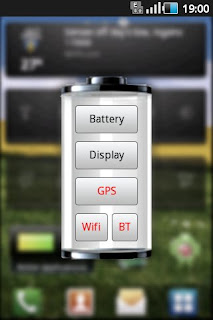Android phones are notorious for their poor battery life. They do the intended job exceptionally well but at a higher cost.
In the Nokia era, a phone lasting 4 or 5 days was a normality than a deviation. We had to think about batteries no more than twice a week. But that golden period of long lasting batteries is gone. Now in the smartphone era a phone which can squeeze the juice to stand a second day is considered relatively good. Android is the most blamed OS among all for its poor battery life.
Best feature of an android ecosystem is its seamless connectivity. Android phones loves to be online. Some might consider it as an agenda being injected to us. But connectivity is the deal of the decade so I don't care, its just freedom for me. Problem with this continuous connectivity is the heavy drain that the connectivity produce on the battery.
The following post is a guide to improving battery life in the least inconvenient way.
Use the android power widget
 |
| Power Widget in android 2.2 |
Power widget is the most useful widget in terms of power saving in an android phone. The power widget controls Wifi, Bluetooth, GPS, Sync and brightness.
- Wifi - Switch it on only when you need it. Otherwise it will search for a wifi network every 10 seconds or so. This will dry the battery in a matter of hours.
- Bluetooth - Not as strong a battery drainer as others but keeping it off will definitely improve battery life
- GPS - The ultimate battery killer. Never leave it open unless you want a dead battery in 4-5 hrs or less.
- Account Sync - This syncs all or the chosen account with the server. The power widget toggles the mail sync.
- Brightness - Controls the brightness in three steps. Lowest one is more than sufficient and is healthy for the eyes in an indoor setting but in outdoors you might need a brighter setting.
Keep the number of home screen widgets to a minimum
Widgets are small snippets of programs that are continuously running in the background. They provide additional information and make easy the use of phone. They are decremental to the battery life as they use the battery whenever there is a need to fetch data to the home screen.
System widgets like the battery widget will access only the system's internal resources but things like weather widget needs connectivity frequently to fetch the data. So I suggest limiting them to essential minimum. Also keep the update interval to the maximum possible. You don't want to get updated on national news every 5 minutes, do you?
Use a reasonable screen timeout with a soft-key screen turn off button
Keep the automatic screen time out to 5 seconds and you will find yourself getting irritated by repeatedly switching on the screen even during a single task. And every time you turn it back on, you are draining the battery. Keep it to 5 minutes and you will find the phone staying far too longer in the 'on' state which also drains battery. How would you tackle this problem?
I suggest keeping the screen timeout to 1 minutes and using a screen turn off button. Make it a reflex to turn off the screen as soon as you complete the task in hand. You can use the Power button (not the widget one, but the actual hard button) for turning the screen off. If you are reluctant to use the hard button for the fear of damaging it with frequent use, I suggest use of an on-screen toggle for screen turn off. You can use widgetsoid2.x to create a screen turn off toggle.
Say NO to task killer
Don't be amazed because use of a task killer will actually decrease your battery life. From 2.x android is very good at task management. The system keeps apps in memory only if it feels a recent requirement. If you kill the app using a task killer, the system has to restart the app from scratch when required which actually puts more pressure on the processor and drains more battery than when it is keep in the memory in idle state.
Use APNDroid - The second power button
APNDroid is a simple but powerful app that turns off the network on a single click. This offers a large boost on the battery life but has the disadvantage of losing connectivity. But as you can get online using the APNDroid toggle button in 3-4 seconds, I think it doesn't matter much.
Airplane mode
I agree that airplane mode is not a normally intended state of cell phone, but if you are in a situation where a call is not allowed, I suggest keeping the phone in this mode. Keeping the phone in airplane mode is almost same as switching it off, but has an advantage of getting back to connected state in seconds.
Use Battery Friendly Apps
Some apps use battery way more than others. Also system upgrades might cause some apps to drain more battery than before. In my case an app, network monitor, drained battery way more quickly when I upgraded my samsung galaxy ace to gingerbread. I suggest you to read reviews carefully before installing an app.
The apps with greatest chance of killing your battery are those that have to be run all the time. For example, anti virus apps. Select ones which causes the least burden on the battery life.




